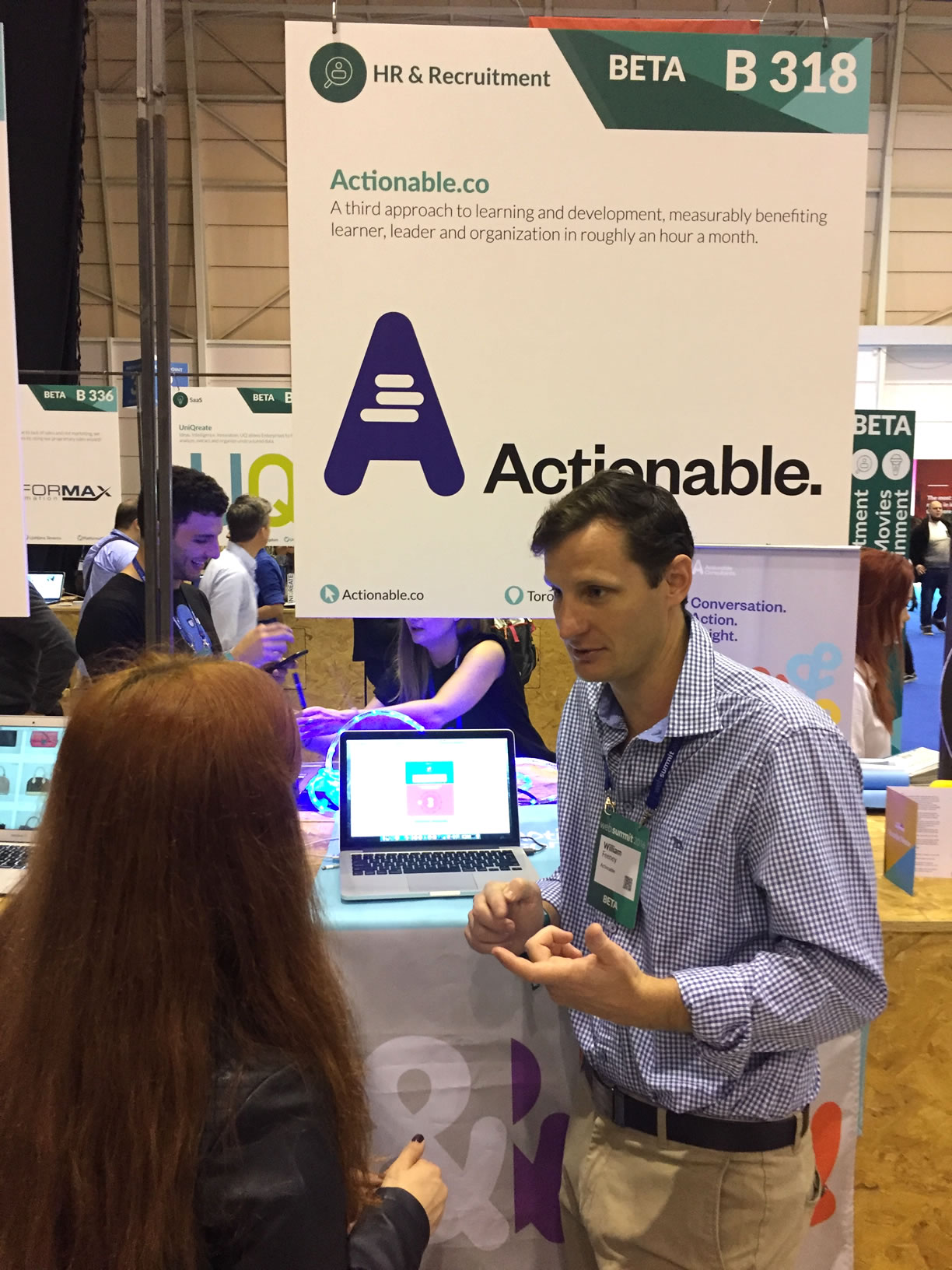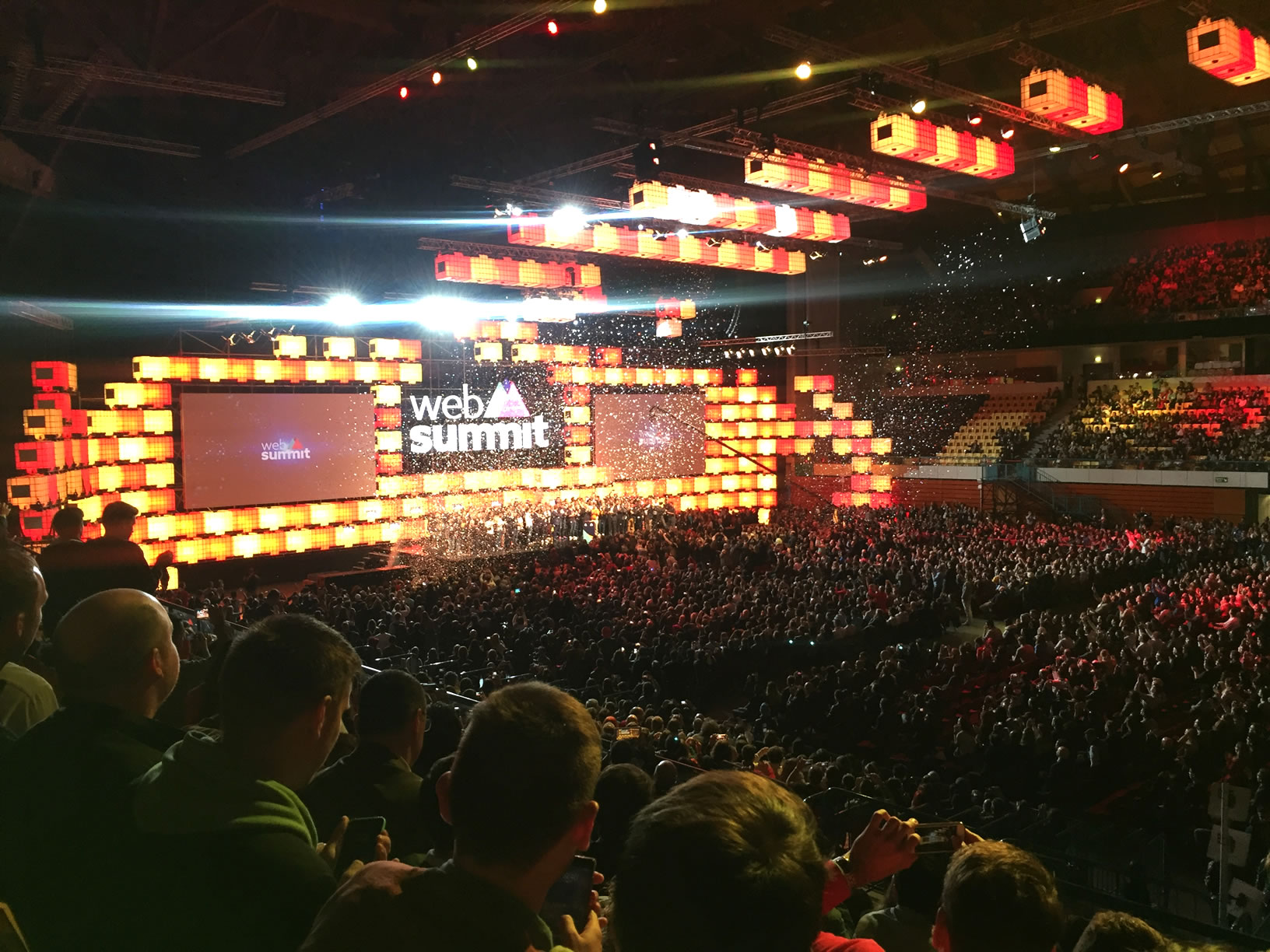Lisbon was a perfect location for this year’s Web Summit, an elaborate web of detailed mosaic cobblestone streets, an apt metaphor for the hyper connectedness of the online world. Its friendly citizens ready to share their culture (and public transport) were generous hosts to the 53,000 attendees from over 150 countries.
The main purpose of Enabled’s visit to Web Summit was to support our partnering client Actionable.co in the promotion of their recently released corporate learning platform. Beyond this, we were also curious to see what people cared about in the field of technology.
 Our partnering client working hard from the Actionable exhibition booth
Our partnering client working hard from the Actionable exhibition booth
Event setup
The event itself was very well managed, with a registration booth greeting us at the airport guiding us to the transport options, including prepaid public transport tickets to see the week through.
Entry to the exhibition site flowed well and we were even treated to a fresh Pastel de nata (a sweet Portuguese tart) to munch on while we explored the 4 exhibition halls and numerous food trucks that supported the event.
Besides being the largest I have attended, on the surface, the summit looked similar to most conferences. The exhibition halls were divided up into large and small spaces. Each hall housed 3 main stages: two larger stages, each dedicated to a topic stream; and a more intimate stage allocated to the Pitch competition and technology demos.
Despite two dozens or so larger players, the majority of the exhibitors were all in the startup space.
The ultimate purpose
Under the surface, the Web Summit’s engine is at work. The whole conference is driven as a funnel for the Venture Capitalists and Tech Investors to discover the next big thing.
The event provides a forum for scouts to gather en masse highlights from the showcasing startups. Investors then arrange meetings with shortlisted business that align with their portfolios. These startups are divided into 3 categories: Alpha, Beta and Start.
A startup graduates through these levels by attending multiple Web Summit and satellite conferences. Investors can then watch how these startups mature across a few years. This allows substance to rise over fashionable ideas.
What we found refreshing is the Web Summit organisers have 2 levels of development before the business is considered to be started. Whereas here in Australia, a business is labeled a startup even at the idea stage.
Speaker Gary Vaynerchuk (whose talk I’ll profile later) even pinpointed the fake startup pentominium, appealing to the industry and practitioners to stop faking.
His extreme reason was the rising suicide rate amongst the startup community. Although failure is meant to be permitted (even glamorised), it is not for everyone. Hence, starting a business is hard and should be left to the tenacious.
These 2 levels before ‘Start’ are sensible and should be strictly adopted across the startup community.
Consider treating employees as customers rather than a workforce.
Presentation highlights
In our opinion, the presentation content was sometimes hit-and-miss. We appreciated that the best talks were not too promotional; and that they had the most impact when covering a case study or learnings the company had been through (seems to be good advice for any content marketer).
Watching talks in the main auditorium was generally more rewarding as the topics were mixed rather than filtered to a single topic stream.
Side note: this is good example of the shortfall of FaceBook’s timeline algorithms which seek to show us only what we are interested in.

Here are the talks that we found most interesting.
Anne Pascual - IDEO - Designing at Scale
Take-away: Anne described a number of case-studies which showed IDEO’s process of understanding the human factors before any solution is considered.
Her Lufthansa example demonstrated the effort they go to, with staff traveling as passengers on several flights, and setting up a fake airliner in a warehouse to test their ideas and solution.
Learn more about this case study on their website.
Des Traynor - Intercom - Keeping your product relevant
Take-away: I already understood that Intercom was a considerable user of Jobs To Be Done techniques (which we wrote about here) both in their product development but also in their marketing communication. Des’ presentation did indeed profile how important JTBD is to maintaining a position in the market.
He explained the myth that starting up is the hard part, but rather, it is harder to maintain market position. Too many mature companies start focusing on enriching product features or worse, optimisation, to attempt to make the business more profitable. This draws attention to the business itself rather than the problem (job) which it initially set out to solve.
Take your eyes off the problem and soon a competitor will be solving it better.
Ryan Smith, Jarrod Smith - Qualtrics - Customer experience in the Millennial age
Take-away: Millennials are orientated towards experiences and causes rather than take-home pay and performance bonuses. “Offer a cash bonus or a holiday, even if the holiday cost the business half the amount, and a Millennial is likely to choose the holiday.”
This level of experience even goes as far as the work environment. Consider treating employees as customers rather than a workforce.
Starting a business is hard and should be left to the tenacious.
Joseph Gordon-Levitt - The difference between a crowd and community
Take-away: Joseph profiled HitRecord where the website’s community work on each other’s projects. When these projects reach commercialisation, each of its contributors are fairly paid a cut.
This shows crowdsourcing does not need to only be a win for the community’s owner.
Gary Vaynerchuk - Vaynermedia - Afraid to fail because of other people’s opinions
Take-away: This was certainly the most colourful and energetic presentation we observed. Gary passionately appealed to the audience to be authentic, and gave ample evidence to the pace of change that businesses and brands face in this hyper connected world.
He exclaimed that mass advertising is dead and that a pop-up ad is stealing our most valuable resource (time), and that we as consumers are no longer up for that.
He also explained that it is the best time to be an entrepreneur. Not to take the responsibility of entrepreneurship lightly, but we all have the power in our pocket to be our own media production company, and no one can stop us. Not even Trump :)
Relating back to Australia
We met a number of exhibitors who were sponsored startups of larger corporations. These incumbents run a program to sponsor startups, who may even become competitors to their own core business.
These enlightened companies understand it is better to own a bit of a disrupting startup, than be the prey of a new business model from an unknown competitor. While this practice makes tremendous sense over there, it is presently alien to most Australian corporations.
Quick example
MiniBrew is a very similar product to BrewArt, yet culturally so different as they were released by a small startup vs. a larger corporate (Coopers).
 MiniBrew and mobile app. Source: Cool Material
MiniBrew and mobile app. Source: Cool Material
Netherlands-based MiniBrew is much more community-orientated, winning fans before a saleable product exists (i.e. pre-commerce). They also have a successful campaign on Indiegogo. Meanwhile, Australia-based Coopers with a traditional product release, was secretive until the launch, with a bias towards traditional retail partners.
Which will come out on top? Time will tell.

